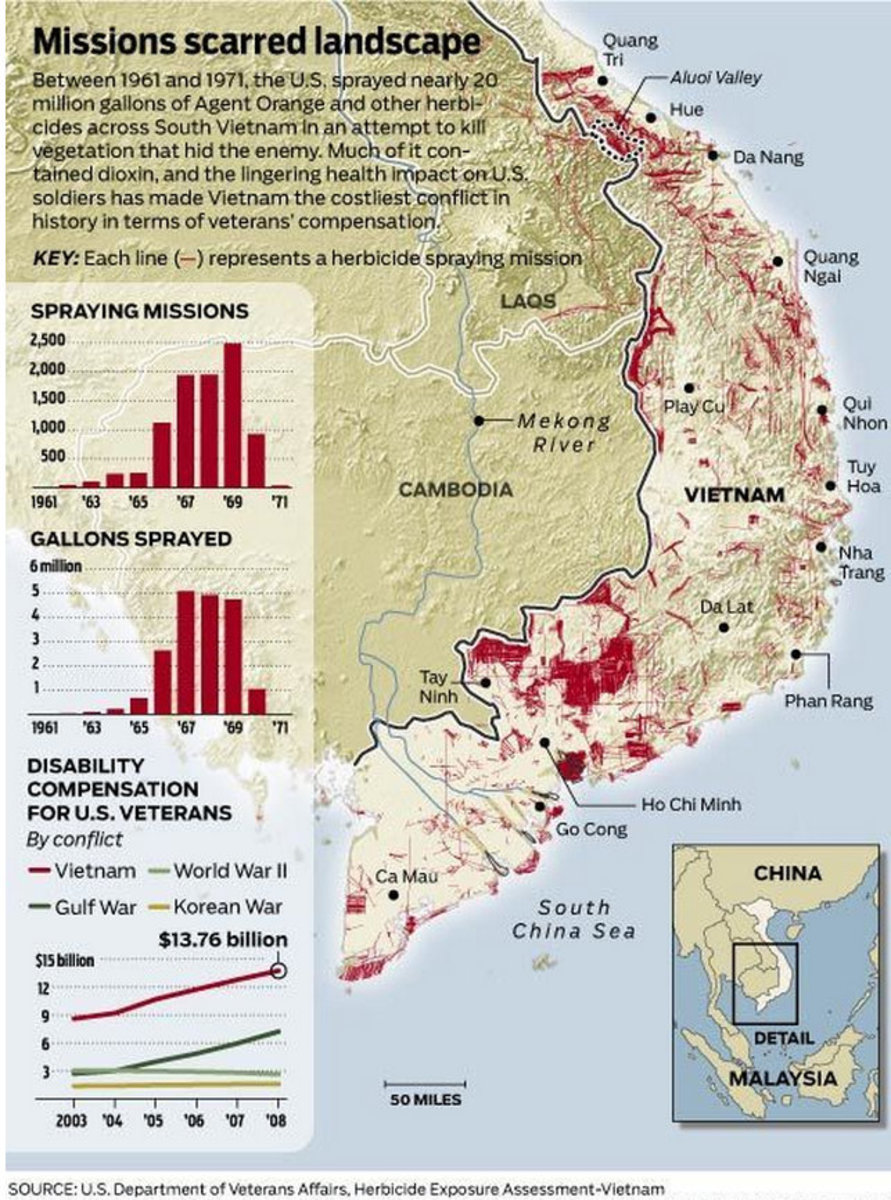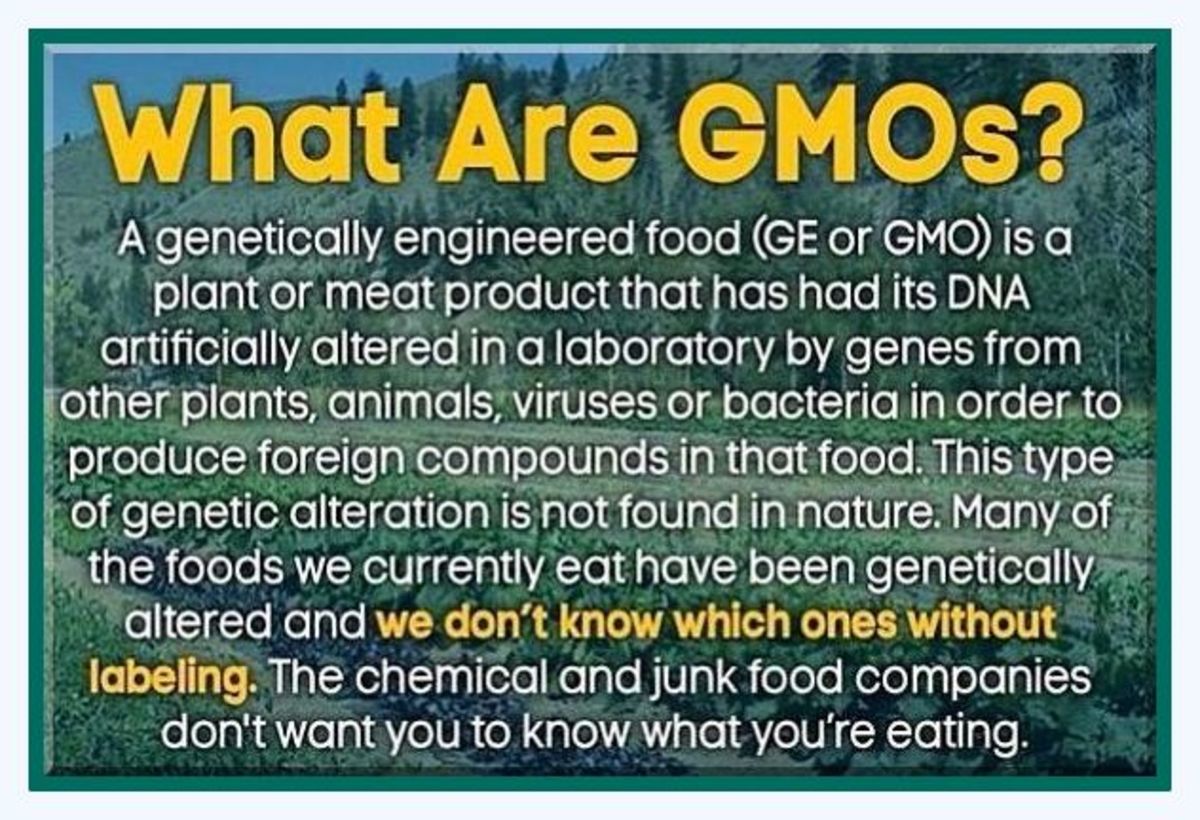Agent Orange Lethal Killer

Past, Present, and Future
With the exception of Vietnam era vets and their families, most Americans have nearly forgotten the war in Vietnam.Yet, we are still left and are dealing with the residual spillover resulting from this war.
Illnesses resulting from Agent Orange, drug and alcohol abuse, Post Traumatic Stress Disorder, high divorce rates, and homelessness can at least in part, be attributed to this spillover. Each of these problems merits its own analysis, so in respect to that, we will focus on Agent Orange and its affect on our past, present, and future. We will look at the many veterans that have been affected, as we also take a glimpse at how Vietnam's civilian population has been impacted.
Background
Prior to its use and introduction to Vietnam in 1961, the American government experimented with Agent Orange in both the United States and in Puerto Rico. Having deemed these experiments a success, a commitment was made to use it in Vietnam.
Agent Orange was just one of fifteen defoliants used in Vietnam. It was the most widely used and designated one of the "Rainbow Chemicals," the others being Agents White, Blue, Purple, Pink, and Green. They were shipped and stored in 55 gallon drums which were color coded by a stripe around each one. Agent Orange was so deadly because it was contaminated with TCDD a carcinogenic dioxin, produced in the manufacturing process. TCDD, is the most highly toxic man made chemical known.
Agent White, the second most widely used herbicide contained picloram, which caused, weight loss, weakness, diarrhea, nerve system damage, and in the long term, liver damage. Agent Blue contained arsenic and Agents Pink and Purple have been found to be even more deadly than Agent Orange.
These chemicals were produced by Dow, Mansanto, Hercules, and Diamond Shamrock. Past lawsuits claim that these companies knew more about the harmful effects associated with these chemicals, than they revealed.
Illnesses and maladies attributed to Agent Orange:
1) Skin Irritations and diseases like chloracne.
2)Neurological issues.
3)Nerve disorders to include peripheral neuropathy.
4)Miscarriages in women.
5)Type 2 diabetes.
6)Birth defects, physical deformities, and spina bifida.
7)Cancers: multiple myeloma, respiratory system cancers, Hodgkins disease, prostate cancer,
leukemia.
Ecology
In November of 1961, Agent Orange was being used in a selective case by case scenario, employing the aid of South Vietnam's military. By January of 1962, using the code name"Operation Hades," the spraying began. The code name, "Operation Hades," was considered a PR no-no, so the new code name, "Operation Ranch Hand" was selected.
The U.S. military sprayed thick growths of vegetation and heavy jungle with Agent Orange in South Vietnam, Laos, and Cambodia. The intention was to remove the cover that snipers, Viet Cong, and the NVA (North Vietnamese Army) used to maneuver and fight under. In the process the food supply was tainted as well.
The resulting damage could sometimes be seen in as little as 24-48 hours. Agent Orange kills a large assortment of vegetation and in the process, roots are killed and leaves fall off the trees. Vegetation is left blackened and a sharp unpleasant odor is noticeable.
In this part of the world, monsoons occur on a yearly basis. During this rainy season topsoil washes away, leaving dioxin tainted soil behind.
Spraying was also done in the close vicinity of many of the military installations. Soldiers in and around those bases, having been assured there was no health risk, showered, drank, and cooked with the water that became contaminated as a result of these sprayings.
Although it is approaching nearly forty years since the war has ended, just as in the past Vietnam vets and Vietnamese civilians are presently experiencing effects from the use of Agent Orange.
Vietnam Vets
It took the Veterans Administration sixteen years after the war ended, to acknowledge any connection between the returning service men's illnesses and the use of the defoliant, Agent Orange. The first three illnesses recognized by the Veterans Administration were soft tissue sarcoma, non-Hodgkin's lymphoma, and chloracne. Chloracne, has been linked to dioxin by chemical companies, decades prior to this.
1991-1997, saw them again add ten more diseases to the list linked to coming in contact with Agent Orange. In the following six years, two more diseases were added to the list.
There are still a lot of uninformed veterans out there who are unaware that some of their health problems may be related to service rendered in Vietnam. Dioxins can be stored in a body's fat for decades, before any serious health issues appear.
Veterans exposed to Agent Orange develope prostate cancer at twice the rate than those who were not exposed. The alarming fact here is that exposed vets showed more than three times the rate of metastasized cancer-indicating it spread to the bones and the lymph nodes having the potential to become lethal. Many cancers come about by the time one reaches his/her sixties, so there are still a lot of vets out there who need screening.
In 1988, the Pentagon put together a classified report with data linking Agent Orange to twenty-eight life threatening illnesses, including birth defects, skin disorders, neurological defects, as well as every cancer known to science.
One of the most maddening things in this situation is that a veteran filing a claim will have to furnish proof that he/she served in Vietnam. This is an organization that keeps records on everything, yet its members have to furnish proof of serving in a war. Typically, it can take anywhere from six to fourteen months for a claim to be approved or denied. Many vets give up on the bureaucratic red tape and saddest of all, some even pass away before they have the chance to receive assistance.

Vietnamese Civilians
What must it feel like for a young obstetrician to deliver a baby with no spine and no brain? Or to deliver a baby with its organs on the outside, or no arms, or legs, or eyes? Such was the case for Dr. Nguyen Thi Ngoc Phuong in 1968, just after the U.S. expanded the use of herbicides in Vietnam, by the millions of gallons. She works at Tu Du Hospital in Ho Chi Minh City, previously the South Vietnam capital, Saigon. This hospital contains the largest maternity ward in Vietnam.
Again, how would it feel to lose five children at an early age as well as husband? How would it feel to have two disabled daughters to care for, everyday? How would it feel to have one healthy offspring out of eight? This is the case of the widow, Dao Thi Kieu, though I am sure she is thankful that her youngest son is healthy.
The Vietnamese government has asked the United States for assistance in caring for some of its disabled children. They have also requested assistance in the cleanup of the contaminated land and waterways still containing very high levels of dioxins. In a country that seems reluctant or slow to help its own service men, I don't think the Vietnamese stand much of a chance of that request being granted.
Last Comment
In Vietnam, nothing ever really went to waste. The 55 gallon drums used to store defoliants were used over again by American soldiers as well as Vietnamese locals. They often still contained the residuals of the prior contents, when sold or given away. They were used for barbecue pits, shower water containers, and even toilets.
Red Devils of Quang Tri
- Red Devils of Quang Tri
I would like to take time and introduce you to the first unit that I served with in Vietnam. The group as a whole was the 5th Mechanized Infantry Division, originally out of Ft. Carson, Colorado. My unit was...
Pol Pot and the Killing Fields
- Pol Pot and the Killing Fields
Pol Pot From 1975-1979, Cambodia's citizens were under the brutal rule of Pol Pot; who ordered the torture, rape, starvation, and murder of his fellow countrymen. If the Native American removal of 1830 in the...
Getting A Job If You Are A Temp
- Getting A Job If You Are A Temp
Getting hired on permanently if you are a temporary worker.
Black Seminoles
- Black Seminoles
Spain's King Charles ll issued an edict in 1693, which stated that any male runaway slave from any English plantation would be granted freedom and refuge upon arrival in Spanish held Florida. There were however two stipulations: (1) Join the...
Bullying In School
- Bullying In School
The school years, kindergarten through the twelfth grade, are the years our youth develop physically, socially, emotionally, and academically. Think about it, this is an intense learning period where we...









